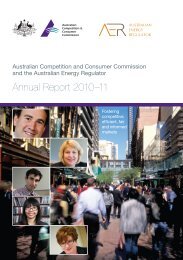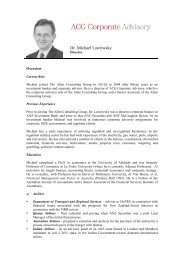Transend - Appendix 5 Renewal capital expenditure - Australian ...
Transend - Appendix 5 Renewal capital expenditure - Australian ...
Transend - Appendix 5 Renewal capital expenditure - Australian ...
Create successful ePaper yourself
Turn your PDF publications into a flip-book with our unique Google optimized e-Paper software.
Burnie-Waratah 110 kV Transmission Line Wood Poles<br />
TNM-CR-808-0888<br />
Issue 1.0, November 2008<br />
2.1 RELIABILITY<br />
Since the transmission line was commissioned in 1967, 41.5 per cent of the wood poles have been<br />
replaced as they have been assessed as no longer in a serviceable condition. There have been no<br />
physical wood pole failures caused by structure failure on this transmission line since<br />
commissioning.<br />
Experience indicates that a small percentage of poles show marked deterioration in the first 15 to<br />
20 years of service, due to ground water, soil conditions and flaws or holes creating a micro climate<br />
that promotes decay and deterioration of the wood pole. The rate of deterioration can be decreased<br />
by the application of decay control maintenance treatment, especially when applied to sound wood<br />
adjacent to the decayed part.<br />
The pole failure curve for this transmission line, against the HEC/Aurora historical and estimated<br />
treated pole survival rate, shows that the poles on this transmission line are failing faster, in that<br />
after 42 years of service 41.5 per cent have been condemned versus the HEC/Aurora estimated<br />
failure rate of 35 per cent condemned (see figure 2).<br />
Figure 2 – Actual wood pole failure rate vs. HEC/Aurora historical and estimated failure rate<br />
Number of Poles Remaining<br />
450<br />
400<br />
350<br />
300<br />
250<br />
200<br />
150<br />
100<br />
50<br />
0<br />
0 5 10 15 20 25 30 35 40 45 50 55 60 65 70 75 80 85 90 95<br />
Age<br />
HEC/Aurora Historical & Estimated Treated Pole Survival Rate (# of poles remaining)<br />
Actual Treated Pole Survival Rate (# of poles remaining of those installed in 1966)<br />
The actual failure curve when forward estimated indicates that of those poles installed in 1966, at<br />
least ten poles are expected to require replacing annually from now on. As testing is conducted on<br />
a three year cycle, this equates to at least 30 poles expected to be condemned every three years.<br />
The forward estimated failure rate indicates that the last original treated wood pole on this<br />
transmission line will be replaced in 2033 (67 years old) as against 2039 (73 years old) from the<br />
HEC/Aurora data.<br />
2.2 PHYSICAL CONDITION<br />
The poles are considered to be in serviceable condition until the condition assessment determines<br />
that the wood pole no longer has the required pole strength safety factors, and is condemned.<br />
Further information on wood pole condition is presented in section 2.3 below.<br />
Page 6 of 9 © <strong>Transend</strong> Networks Pty Ltd<br />
UNCONTROLLED WHEN PRINTED<br />
100







